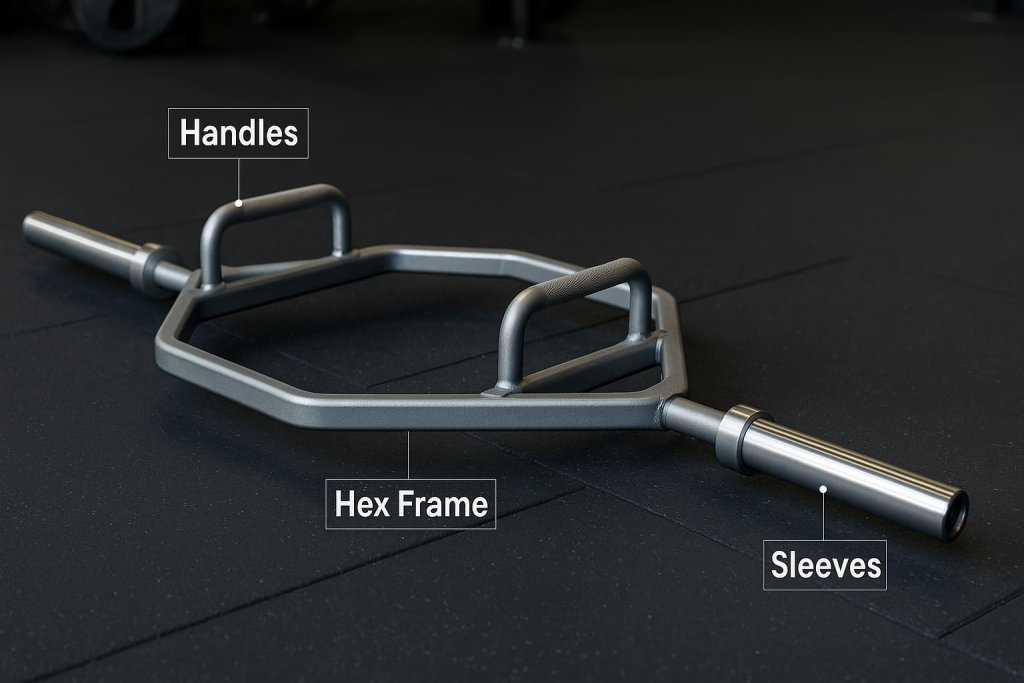Most standard trap bars weigh between 45 and 60 pounds (20–27 kg), but the exact weight can range from 30 pounds (13.6 kg) up to 75 pounds (34 kg), depending on the design and manufacturer. Knowing how much a trap bar weighs is crucial for tracking your lifts, programming strength progress, and preventing errors in your workout. Whether you’re a beginner or a seasoned lifter, understanding trap bar weight ensures safe and effective training.

Trap bars come in several shapes and sizes—traditional hex, open hex, and rackable versions—all with different weights. This guide covers typical weights, why they vary, how to find the weight of yours, and which type is right for you. Always check your gym’s bar for a manufacturer’s label or weigh it yourself to be sure. For detailed specs, see your brand’s official page or ask a staff member.
What Is a Trap Bar?
A trap bar (also known as a hex bar) is a specialty barbell with a hexagonal or diamond-shaped center, allowing you to stand inside and grip handles at your sides. It’s used for deadlifts, shrugs, and carries, reducing lower-back strain compared to a straight barbell.
- Main benefits: Improved lifting mechanics, reduced spinal load, and safer deadlifts for most lifters.
- Common exercises: Trap bar deadlift, farmer’s walks, shrugs, overhead presses.
Standard Trap Bar Weights
1. Standard/Traditional Hex Bar
- Typical Weight: 45 pounds (20 kg)
- Most common in commercial gyms
- Usually 56–60 inches long
2. Heavy-Duty Trap Bars (XL/Open-Back)
- Typical Weight: 55–65 pounds (25–29 kg)
- Extra steel for added rigidity and load capacity
- May include extra features: rotating or high handles
3. Lightweight/Home Gym Trap Bars
- Typical Weight: 30–40 pounds (13.6–18 kg)
- Compact, space-saving, often found in smaller gyms or home setups
4. Oversized/Professional Bars
- Weight: Up to 75 pounds (34 kg)
- Designed for powerlifting or high-capacity use
- Not common for beginners
| Trap Bar Type | Weight (lb) | Weight (kg) |
|---|---|---|
| Standard Hex (Gerard) | 45 | 20 |
| Heavy-Duty/Open Hex | 55–65 | 25–29 |
| Lightweight/Compact | 30–40 | 13.6–18 |
| Oversized/XL | 70–75 | 32–34 |
Why Does Trap Bar Weight Vary?
- Design differences: Hex, open hex, and rackable bars use different shapes and lengths.
- Material: Thicker steel or additional welds add weight.
- Features: Extra handles, knurling, or rotating grips increase bar weight.
- Brand: Every manufacturer’s “standard” can differ.
If in doubt, weigh your bar on a digital scale or check with your gym staff. Always confirm before logging your lifts!
How to Find Out Your Trap Bar’s Weight
- Look for a sticker or engraving: Many commercial bars list the weight on the frame or handles.
- Check the brand/model: Google the make/model for exact specs.
- Use a scale: Weigh yourself, then again holding the bar, and subtract the difference.
- Ask gym staff: Most gyms keep a reference sheet for specialty bars.
Trap Bar Weight vs. Olympic Barbell
- Trap Bar: 30–75 lb (13.6–34 kg), most commonly 45–60 lb.
- Olympic Barbell: 45 lb (20 kg) (men), 33 lb (15 kg) (women).
Important: Unlike Olympic bars, there’s no universal standard for trap bar weight. Always confirm before logging your numbers.
Frequently Asked Questions
Is a trap bar deadlift lighter than a barbell deadlift?
Not necessarily—trap bars often weigh the same or slightly more. Double-check the bar weight and add it to your total.
Can you use a trap bar for squats or presses?
Yes! Many lifters use trap bars for loaded carries, presses, and even floor presses. Check weight capacity and handle height.
Are all trap bars 45 lb?
No. While 45 lb is most common, many weigh 50, 55, or even 60+ lb. Always confirm for accuracy.
What about “open” or “rackable” trap bars?
Open/rackable bars are often heavier (55–65+ lb), especially with extra features.
Conclusion
In summary, most trap bars weigh between 45 and 60 pounds, but the weight can range from 30 up to 75 pounds depending on design and brand. Always check the actual weight before recording your lifts to ensure accurate progress and safety.
